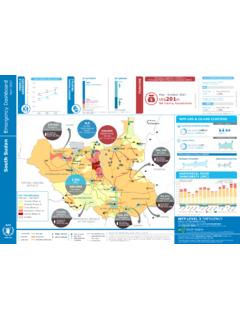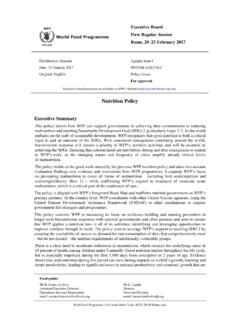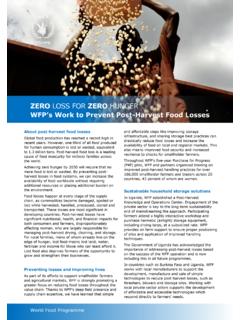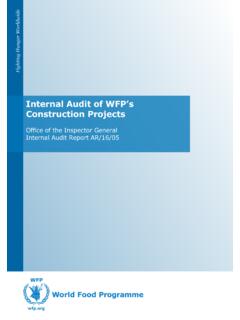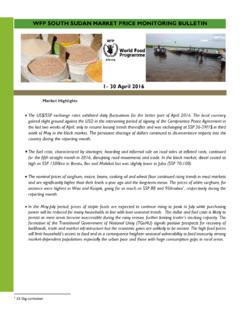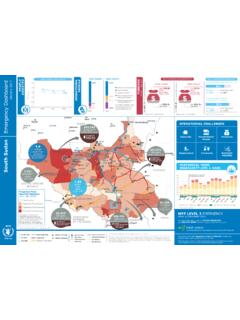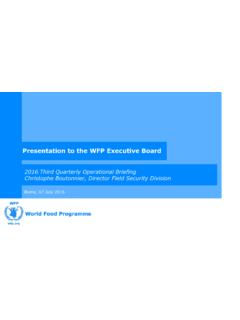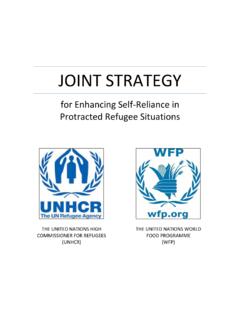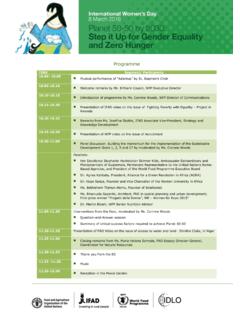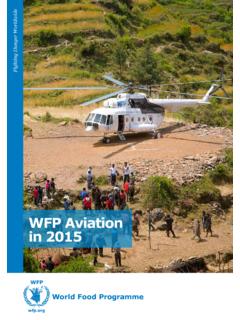Transcription of Guidance for Temperature Control Storage & …
1 WORLD FOOD PROGRAMME. Guidance for Temperature Control Storage & Transportation (Nutritious Food Products). Sahel Operation 21 March, 2012. Logistics Development Unit (LDU) WFP ROME. WORLD FOOD PROGRAMME. BACKGROUND. WFP expanded the use of new type of nutrition products such as ready-to-use supplementary food (RUSF) and Super Cereals Plus. Currently those products are produced by limited suppliers, such as NUTRISET, CERFAR and MICHIELS. The field conditions do not always allow an optimum conservation and transport of nutritious food products which can lead to the deterioration of the nutritional properties of the product. This document aims to provide rapid and basic information for logisticians on best nutritious foods management practices.
2 Firstly, the Guidance specifies various Temperature exposures to the three products and their shelve life. Secondly, it provides recommendations for Temperature Control and stock management in terms of products' shelve life. Finally, the document outlines key recommendations regarding Storage management and transportation of the products. 1 GENERAL PRODUCT INFORMATION. PRODUCTS < 30 C 30 40 C 40 C. Plumpy Sup 24 months 16 months 12 months Plumpy Doz 24 months 16 months 12 months Super Cereal Plus 12 months 8 months 6 months Note: This Guidance note should not be considered for locally produced products. Temperature AND SHELVE LIFE (OPTIMUM Storage CONDITIONS): Plumpy Sup: The speed of degradation reactions increases in high Temperature of Storage .
3 At 40 C and above in the Storage , the product starts to degrade dramatically. Plumpy Doz: Same as above, the speed of degradation reactions increases in high Temperature of Storage . At 40 C. and above in the Storage , the product starts to degrade dramatically. Cereal Plus: The speed of degradation reactions increases in high Temperature of Storage . At 40 C and above in the Storage , the product starts to degrade dramatically. 2 - Temperature Control . - Storage Temperature Control . The Temperature of 35 C is the upper limit for optimum preservation for the three products as recommended by the manufacturers. A Temperature of 40 C is the accelerated threshold of the degradation mechanisms and reactions of the products.
4 Guidance for Temperature Control Storage & Transportation (Nutritious Food 2. Products). WORLD FOOD PROGRAMME. a. IN HUBS. Heat and humidity are main factors for degradation of the products. Even if we have hermetic / aluminium coated packaging (sachets) to protect the products from deterioration, we have to avoid any exposure to water and humidity. Table below specifies the measures that should be taken to prevent deterioration of the products in the warehouses. RECOMMENDED MEASURES: 1 - Air Conditioner (AC) should be installed in the main Hubs to avoid high Temperature and when the products will be stored longer than six months (that includes hot season).
5 2 - Leave the cartons on the pallets without stacking them. You can, at most, put another or two layers of cartons on the top of a full pallet. 3 - Storage standard must be respected (products should be stored at least 10 cm above the floor and a space of at least 30 cm between the Pallets. 4 - Install three thermometers in each warehouse (one at the entrance, one in the middle and one in the back). 5 - Temperature should be recorded regularly ( , , ) by the store keeper and written on the Temperature sheet which should be displayed near the store keeper's desk to be seen by everyone. 6 - If possible, products should be kept separate from other foodstuffs where a risk of microbiological contamination might exist.)
6 At least, a separated area should be used in the warehouse to prevent from contamination. 7 - Respect the Guidance of Storage facilities in term of hygiene and security. b. IN PRIMARY WAREHOUSES. In the main warehouses where the food products will be stored for an extended time period, measures as recommended in the table above (recommendations 1 through 7) should be taken. c. IN SECONDARY WAREHOUSE. If there is no AC in the warehouse, comply with the standard ventilation protocols. The measures as recommended in the table above (recommendations 2 through 7) should also be taken. Storage RECOMMENDATIONS. The conditions in the warehouses in the Sahel Region (high temperatures inside warehouses) are not usually suited for long term Storage of nutritious food products.
7 Thus, for food products to remain in good condition, it is important to keep Temperature inside the warehouses at a maximum 35 C. Guidance for Temperature Control Storage & Transportation (Nutritious Food 3. Products). WORLD FOOD PROGRAMME. a. OPTIMISATION OF EXISTING Storage FACILITIES. Since constructing an insulating panels or installing ACs for an entire warehouse would be too costly, we recommend construction of an insulated Temperature controlled space inside a warehouse. The main objective is to create a Temperature and humidity controlled Storage space for maximum conservation of nutritious food products. In order to achieve this objective, we need to create an insulated and Temperature controlled room inside an existing Storage structure.
8 The Head of Logistics will decide on the best location for the construction of the insulated structure within the existing structure. The recommendation is that an insulated space can be constructed inside the warehouse where a separate air conditioning units would be installed. Cooling down individual warehouse spaces is a cheaper alternative to industrial sized air conditioners. Considering the environment in the Sahel region, cement blocks and wood planks can be used to build the insulated space. This type of insulation would lower down substantially Temperature inside the structure and would also help Control humidity. For better Temperature Control , corners around the door and ceiling of the structure should be well insulated.
9 In addition, air conditioners must have exhaust hose going out a window or outside an external wall. Thus, the new structure must share one or two walls of the main warehouse. For better insulation, if possible, a cob layer could be added to the outer walls of the cooling structure. Guidance for Temperature Control Storage & Transportation (Nutritious Food 4. Products). WORLD FOOD PROGRAMME. OPTIMISATION MODEL. A/C - 1 Outer Wall of the W/H & cooling structure Main Warehouse Structure Chicken Wire Cob Layer 5cm (Optional). Insulated Structure: Outer Wall of the W/H and cooling Hole #1 in the Ceiling (20X30cm). structure X. Chicken Wire A/C - 2. A row of Cement Blocks Cob Layer 5cm Main (Optional) Cob Layer (5cm) Entrance to the W/H.
10 Chicken Wire Insulated Door Hole #2 in the Ceiling (20X30cm). Ceiling Structure: Hole in the Ceiling (20X30cm) for air circulation Wood Layer 10 cm Cob Layer Wood Layer When constructing the ceiling, it is important to leave a space between the warehouse ceiling and the new structure for better air circulation. In addition, few holes must be drilled in through the ceiling. Our recommendation for a space of 1000 m2 drill four or five holes of 20X30 cm which is essential for air circulation in the cooling space. Guidance for Temperature Control Storage & Transportation (Nutritious Food 5. Products). WORLD FOOD PROGRAMME. b. MOBILE Storage SOLUTIONS. ISO Containers: Insulated containers with or without built-in refrigeration units can be used for Temperature Control of nutritious food products.
